Chapter 14: Question & Answers
1 Advanced costing methods

 ROCHE (ABC)
ROCHE (ABC)
Questions
Roche has recently set up a small business, which manufacturesthree different types of chair to customer order. Each type is producedin a single batch per week and dispatched as individual items. The sizeof the batch is determined by the weekly customer orders. The threedifferent types of chair are known as the Type A, the Type B and theType C. The Type A is a fully leather-upholstered chair and is the mostexpensive of the range. The Type B is the middle-of-the-range chair, andhas a comfortable leather seat. The cheapest of the range, the Type C,is purely a wooden chair, but Roche feels it has great potential andhopes it will provide at least 50% of the sales revenue.
Roche has employed Mr F, an experienced but unqualified accountant,to act as the organisation's accountant. Mr F has produced figures forthe past month, July 2010, which is considered a normal month in termsof costs:
Profit statement for July 2010:
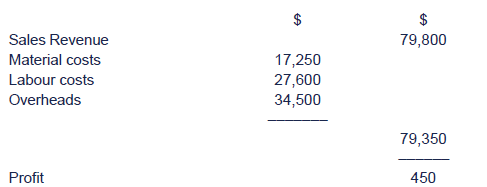
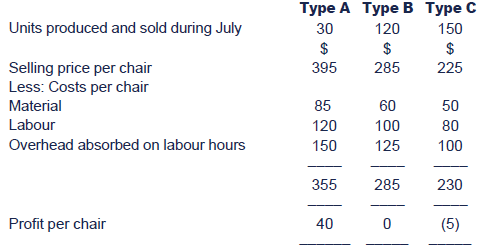
Roche hopes to use these figures as the basis for budgets for thenext three months. The managers are pleased to see that the organisationhas made its first monthly profit, however small it might be. On theother hand, they are unhappy with Mr F's advice about the loss-makingType C, which is, either to reduce its production or to increase itsprice. Roche's managers are concerned because this advice goes againstits marketing strategy. After much discussion Mr F says that he hasheard of a newer type of costing system, known as activity-based costing(ABC), and that he will recalculate the position on this basis. Inorder to do this, Mr F has extracted the following information:

The overheads included in July’s profit statement comprised:

Required:
(a) Use the ABC technique to prepare a revised product cost statement for July 2010 such as Mr F might produce.
(b) Drawing upon the information form Roche toillustrate your answer, explain why the use of ABC provides an adequatebasis for Roche's managers to make decisions on the future productionvolume and price of the Type C.


 HENSAU LTD
HENSAU LTD
Questions
Hensau Ltd has a single production process for which the followingcosts have been estimated for the period ending 31 December 20X8:

Three products - X, Y and Z are produced by workers who perform anumber of operations on material blanks using hand held electricallypowered drills. The workers have a wage rate of $9 per hour.
The following budgeted information has been obtained for the period ending 31 December 20X8:

Overhead costs for material receipt and inspection, process powerand material handling are presently each absorbed by product units usingrates per direct labour hour.
An activity based costing investigation has revealed that the cost drivers for the overhead costs are as follows:
- Material receipt and inspection: number of batches of material.
- Process power: number of power drill operations.
- Material handling: quantity of material (sq. metres) handled.
Required:
(a) to prepare a summary which shows thebudgeted product cost per unit for each of the products X, Y and Z forthe period ending 31 December 20X8 detailing the unit costs for eachcost element:
(i)using the existing method for the absorption of overhead costs and
(ii) using an approach which recognises the cost drivers revealed in the activity based costing investigation;
(iii)discuss the implications of Hensau making the decision to switch to ABC
(17 marks)
(b) to explain the relevance of cost drivers inactivity based costing. Make use of figures from the summary statementprepared in (a) to illustrate your answer.
(8 marks)
(Total: 25 marks)

2 Planning with limiting factors

 QUARKO CO
QUARKO CO
Questions
Quarko Co manufactures two products, Xerxes and Yoraths. Noinventories are held. The following data relates to the budget for eachunit of product.
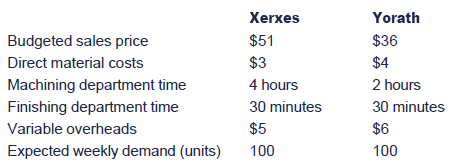
Fixed costs are $13,000 per quarter. Direct materials are known tobe in short supply, with only $600 worth being available to purchaseeach week. There are currently twelve people working in the machiningdepartment (paid $6 per hour) and two in the finishing department (paid$8 per hour). Due to the specialised nature of the work involved in eacharea, skills are not transferable between the departments. Allemployees work a 40-hour week. Assume that there are twelve weeks in thethree month period.
Required:
(a) Calculate the shortfall (in hours) in eachdepartment if production were to reach the expected demand levels at thebudgeted selling prices.
(3 marks)
(b) Calculate the optimum production plan perweek if the company aims to maximise profits, and indicate the budgetedprofit for the three month period.
(12 marks)
(c) Calculate how much Quarko would be willing to pay for more machining hours.
(5 marks)
(Total: 20 marks)

3 Pricing

 CAR COMPONENTS INC
CAR COMPONENTS INC
Questions
Car Components Inc ('CCI') manufactures and sells brake andsuspension components used in the car industry. Some components are soldthrough garages and motor factors to the public but the bulk are solddirect to car manufacturers. In particular, CCI has provided componentsfor many years to Victor Motors, its largest client, who takes 40% ofCCI's output. Pricing has always been based on full production cost plus25%.
Intense competition within the car industry has seen CCI's marketshare decline and last year it only operated at 70% capacity. CCI'sclients have not been immune to industry pressure either and recentlyVictor Motors was bought out by a multinational manufacturer. The newowners have decided that the component contract would now be put out totender each year and have made it clear that price, while not the onlyconsideration, would be a major factor in deciding on the preferredsupplier.
The management accountant of CCI has put together the following cost schedule for the CCI contract for the next year:

Note 1: There is currently $500,000 of materials inventory.If not used on Victor Motor components this would be sold to a thirdparty, but incur a net loss (after delivery charges are taken intoaccount) of $100,000.
Note 2: Victor Motors components are highly specialised. Ifthe contract was lost, then all of the current staff making Victorcomponents would have to be made redundant. Redundancy costsre-estimated to be $500,000 now or $600,000 in one year's time.
Note 3: Fixed overheads consist of unavoidable company-widecosts and depreciation. If the contract is lost then machinery would besold for $600,000 now or $450,000 in one year.
Required:
(a) Calculate the incremental cost of completing the Victor Motors contract for one more year and suggest a minimum tender price.
(8 marks)
(b) Discuss the factors that must be taken into consideration when bidding for the Victor contract.
(8 marks)
(Total: 16 marks)

4 Make or buy and other short-term decisions

 ACCESS INC
ACCESS INC
Questions
Access Inc makes electrically-driven disability scooters aimed atelderly and/or disabled customers. At present wheels and tyres arebought from external suppliers but all other parts are manufacturedin-house. The scooters have a strong reputation due mainly to innovativedesigns, special power units that can be recharged at home and seatsthat enable easy access for a wide range of disabilities. Access Incalso sells power units to other firms.
Current monthly costs are as follows.
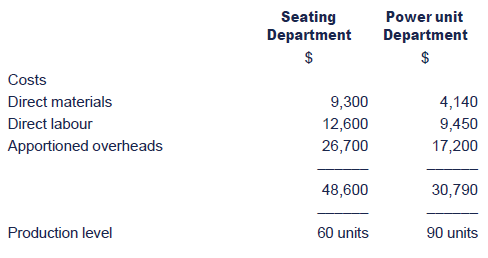
Note: The power unit department currently produces 90 units amonth – 60 being used in Access' own scooters, and 30 being soldexternally at $376 each.
A new order has been won to supply an additional 10 scooters permonth. However, the directors are considering how best to meet theadditional demand:
- Sufficient capacity exists for the company to increase its monthly production to 70 scooters, except that making an extra 10 seating assemblies would require reallocation of labour and other resources from the power unit to the seating department. This would cut power unit output by 20 units per month.
- The alternative course would be to buy 10 seating assemblies from an outside supplier and fit the 10 power units from the present production of 90 units. The cheapest quote for seating assemblies is $610 per assembly.
Required:
(a) Based on the figures given, show whetherAccess should make or buy the extra seats. Discuss what other factorsshould be considered before a final decision is taken to make or to buythe extra seats.
(10 marks)
(b) Comment on the relevance of the apportioned overhead cost figures to your recommendation.
(2 marks)
(Total: 12 marks)


 BROWN LTD
BROWN LTD
Questions
Brown Ltd is a company which has in inventory some materials oftype XY which cost $150,000 but which are now obsolete and have a scrapvalue of only $42,000. Other than selling the material for scrap thereare only two alternative uses for them.
Alternative 1
Converting the obsolete materials into a specialized product which would require the following additional work and materials
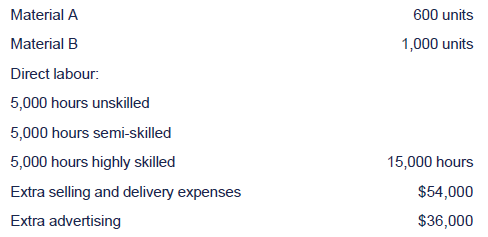
The conversion would produce 900 units of saleable product and these could be sold for $600 per unit.
Material A is already in inventory and is widely used within thefirm. Although present inventories together with orders already plannedwill be sufficient to facilitate normal activity, any extra materialused by adopting this alternative will necessitate such materials beingreplaced immediately. Material B is also in inventory but it is unlikelythat any additional supplies can be obtained for some considerable timebecause of an industrial dispute. At the present time material B isnormally used in the production of product Z which sells at $780 perunit and incurs total variable cost (excluding material B) of $420 perunit. Each unit of product Z uses four units of material B.
The details of materials A and B are as follows:

Alternative 2
Adapting the obsolete materials for use as a substitute for asub-assembly which is regularly used within the firm. Details of theextra work and materials required are:

1,200 units of the sub-assembly are regularly used per quarter at acost of $1,800 per unit. The adaptation of material XY would reduce thequantity of the subassembly purchased from outside the firm to 900units for the next quarter only. However, as the volume purchased wouldbe reduced some discount would be lost, and the price of those purchasedfrom outside would increase to $2,100 per unit for that quarter.
Material C is not available externally but is manufactured by BrownLtd. The 1,000 units required would be available from inventories butwould be produced as extra production. The standard cost per unit ofmaterial C would be as follows:

The wage rates and overhead recovery rates for Brown Ltd are:

The unskilled labour is employed on a casual basis and sufficientlabour can be acquired to exactly meet the production requirements.Semi-skilled labour is part of the permanent labour force but thecompany has temporary excess supply of this type of labour at thepresent time. Highly skilled labour is in short supply and cannot beincreased significantly in the short term; this labour is presentlyengaged in meeting the demand for product L which requires 4 hours ofhighly skilled labour. The contribution from the sale of one unit ofproduct L is $48.
Required:
For each of the alternatives 1 and 2, prepare a cost-benefitanalysis based on a schedule of relevant costs. Your answer shouldinclude a conclusion as to whether the inventories of material XY shouldbe sold, converted into a specialized product (alternative 1) oradapted for use as a substitute for a sub-assembly (alternative 2).
(20 marks)


 CARIBEE LTD
CARIBEE LTD
Question
(a) Next year's forecasted trading results forCaribee Ltd, a small company manufacturing three different types ofproduct, are shown below:

Required:
Explain how the company's forecasted profits would be affected ifproduct C were discontinued. It should be assumed that sales of theremaining products would not be affected; any other assumptions madeshould be included with your explanation
(4 marks)
(b) The production director of Caribee Ltd hasjust been informed that next year's supplies of a material used in themanufacture of each of the three products will be restricted to 92,000kg; no substitute material is available and the estimated consumption ofthis restricted material, per product, is:

The sales director estimates that the maximum demand for eachproduct is that which is shown in the original forecast in (a) above.Assume that inventories of materials, work in progress or finished goodscannot be carried.
Required:
Calculate the optimum quantities of products A, B and C whichshould be manufactured next year in order to maximise company profits.
(9 marks)
(Total 13 marks)

5 Risk and uncertainty

 PRODUCT TOM
PRODUCT TOM
Questions
Product ‘Tom' is a highly perishable commodity which can be soldon the retail market for $20 per case or for animal food @ $1 per case.Tom costs $10 per case from the wholesale market and is only suitablefor sale at the retail market for up to 24 hours after purchase.
Orders for ‘Tom' must be placed in advance each day.
Amanda, a market stall owner, has kept the following records of sales of the Tom over the past 50 days.
Required:
(a) Prepare a summary that shows the forecast net margin earned by Amanda for each possible outcome.
(6 marks)
(b) On the basis of maximising expected value, advise Amanda.
(1 mark)
(c) On the basis of using the maximin and maximax criteria, advise Amanda.
(4 marks)
(d) Use minimax regret to advise Amanda.
(4 marks)
(Total: 15 marks)


 SITERAZE LTD
SITERAZE LTD
Questions
Siteraze Ltd is a company which engages in site clearance and sitepreparation work. Information concerning its operations is as follows:
(i)It is company policy to hire allplant and machinery required for the implementation of all ordersobtained, rather than to purchase its own plant and machinery.
(ii) Siteraze Ltd will enter into anadvance hire agreement contract for the coming year at one of threelevels high, medium or low, which correspond to the requirements of ahigh, medium or low level of orders obtained.
(iii)The level of orders obtained willnot be known when the advance hire agreement contract is entered into. Aset of probabilities have been estimated by management as to thelikelihood of the orders being at a high, medium or low level.
(iv)Where the advance hire agreemententered into is lower than that required for the level of ordersactually obtained, a premium rate must be paid to obtain the additionalplant and machinery required.
(v) No refund is obtainable where theadvance hire agreement for plant and machinery is at a level in excessof that required to satisfy the site clearance and preparation ordersactually obtained.
A summary of the information relating to the above points is as follows:

Required:
(a) Prepare a summary which shows the forecast net margin earned by Siteraze Ltd for the coming year for each possible outcome.
(6 marks)
(b) On the basis of maximising expected value,advise Siteraze whether the advance contract for the hire of plant andmachinery should be at the low, medium or high level.
(5 marks)
(c) Explain how the risk preferences of themanagement members responsible for the choice of advance plant andmachinery hire contract may alter the decision reached in (b) above.
(6 marks)
(Total: 17 marks)

6 Budgeting 1

 BUDGET BEHAVIOUR
BUDGET BEHAVIOUR
Questions
For many organisations in both the private and public sectors theannual budget is the basis of much internal management information. Whenpreparing and using budgets, however, management and the accountantmust be aware of their behavioural implications.
Required:
(a) Briefly discuss four purposes of budgets.
(8 marks)
(b) Explain the behavioural factors whichshould be borne in mind and the difficulties of applying them in theprocess of budgeting and budgetary control.
(12 marks)
(Total: 20 marks)

7 Budgeting 2

 ZERO-BASED BUDGETING
ZERO-BASED BUDGETING
Questions
(a) Explain why Zero Based Budgeting might be a useful tool to employ to ensure that budgetary requirements are kept up to date.
(4 marks)
(b) Describe the steps needed to be undertaken in order to implement a Zero Based Budgeting system in respect of:
- the questioning of why expenditure needs to be incurred
- how a decision is made as to which activities should be provided with a budget, and
- what questions should be asked when budgeted activities need to be ranked to allocate scarce resources.
(8 marks)
(c) Critically assess the use of Zero Based Budgeting as a tool that might be used to motivate employees.
(6 marks)
(d) Explain the advantages of encouraging employee participation in budget setting.
(7 marks)
(Total: 25 marks)

8 Quantitative analysis

 FASHION CO
FASHION CO
Questions
Fashion Co, a manufacturer of fashion garments, is investigatingwhether or not to accept a retailer's order for 100,000 winter coatswhich will be codenamed Winners.
The following information is available in relation to Winners:
(1) The 100,000 garments will be manufacturedin batches of 1000 garments. Fashion Co has been offered a price of$50,000 for each batch of 1000 garments supplied to the retailer.
(2) New machinery costing $250,000 will have tobe purchased for this contract and it is estimated that this machinerywill have a value of $25,000 at the end of the contract.
(3) A 75% learning curve will apply for thefirst 60 batches of Winners after which a steady state production timewill apply. The labour time per batch after the first 60 batches willtherefore be equal to the time for the 60th batch. The cost of the firstbatch was measured at $15,000. This was for 1500 hours at $10 per hour.
(4)Variable overhead will be 30% of the direct labour cost.
(5)Given the above learning effect for labour,direct material will be $10,000 per batch for the first ten batches,$7,500 per batch for the next ten and $6,000 per batch thereafter.
(6) A new warehouse will have to be rented for three months to store Winners at a cost of $5,000 per month
Fashion Co is seeking to achieve a net profit equal to 80% of thesales revenue arising from the manufacture and sale of Winners.
Required:
(a)Prepare detailed calculations to show whether the targeted 80% net profit margin will be achieved.
(12 marks)
(b)Calculate what length of time the second batch will take if the actual rate of learning is
(5 marks)
(c)Suggest specific steps that Fashion Co could take to improve the net margin calculated above.
(8 marks)
(Total: 25 marks)

9 Standard costing and basic variances

 MALCOLM REYNOLDS
MALCOLM REYNOLDS
Questions
Malcolm Reynolds makes and sells a single product, Product Q, with the following standard specification for materials:

It takes 20 direct labour hours to produce one unit with a standard direct labour cost of $10 per hour.
The annual sales/production budget is 2,400 units evenly spreadthroughout the year. The standard selling price was $1,250 per unit.
The budgeted production overhead, all fixed, is $288,000 andexpenditure is expected to occur evenly over the year, which the companydivides into 12 calendar months. Absorption is based on direct labourhours.
For the month of October the following actual information is provided.
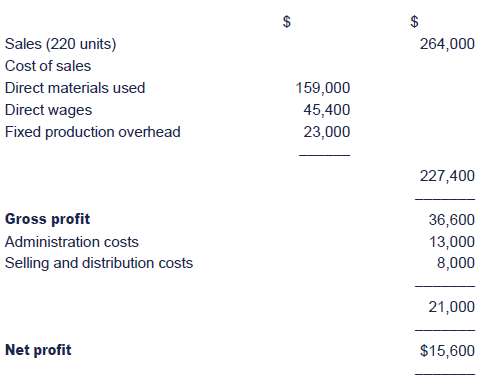
Costs of opening inventory, for each material, were at the sameprice per kilogram as the purchases made during the month but there hadbeen changes in the materials inventory levels, viz.:

Material X purchases were 3,000 kg at $42 each.
Material Y purchases were 1,700 kg at $30 each
The number of direct labour hours worked was 4,600 and the total wages incurred $45,400.
Work-in-progress and finished goods inventories may be assumed to be the same at the beginning and end of October
Required:
(a) to present a standard product cost for oneunit of product Q showing the standard selling price and standard grossprofit per unit
(3 marks)
(b) to calculate appropriate variances for thematerials, labour, fixed production overhead and sales, noting that itis company policy to calculate material price variances at time of issueto production (i.e. based on usage not purchases)and that the firm doesnot calculate mix and yield variances
(12 marks)
(c) to present a statement for management reconciling the budgeted gross profit with the actual gross profit
(5 marks)
(Total: 20 marks)


 MAY LTD
MAY LTD
Questions
May Ltd produces a single product for which the following data are given:
Standards per unit of product:

Actual details for given financial period:

There was no work in progress at the beginning or end of the period.
Required:
(a) Calculate the following variances:
(i)direct labour total;
(ii) direct labour rate;
(iii)direct labour efficiency;
(iv)direct materials total;
(v) direct materials price, based on issues to production;
(vi)direct materials usage.
(b)Discuss whether in each of the followingcases, the comment given as the possible reason for the variance, isconsistent with the variance you have calculated in (a) above.
(i)Direct labour rate variance: the union negotiated wage increase was $0.60 per hour lower than expected;
(ii) Direct labour efficiency variance: the efficiency of labour was commendable.
(iii)Direct materials price variance:the procurement manager has ignored the economic order quantity and, byobtaining bulk quantities, has purchased material at less than thestandard price;
(iv)Direct materials usage variance: material losses in production were less than had been allowed for in the standard;
(20 marks)


 SAM MENDES LTD
SAM MENDES LTD
Questions
Sam Mendes Ltd is a manufacturing company which produces a varietyof products. The following information relates to one of its products -Product W:
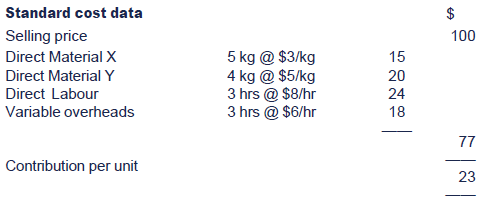
The budgeted production is 24,000 units per annum evenly spreadthroughout the year, with each calendar month assumed to be equal. Marchis a bad month in terms of sales revenue and it is expected that saleswill only be 1,700 units during the month. Fixed overheads were expectedto be $144,000 per year and are absorbed on a labour hour basis.
Actual results for the month of March were that sales were 2,200units at a price of $90. There was no change in stock of finished goodsor raw materials.
The purchases during the month were 11,300 kg of material X at $2.80 per kg and 8,300 kg of material Y at $5.30 per kg.
4,800 labour hours were worked at a rate of $8.10 per hour and 1,600 hours at $8.30.
The actual variable overheads for the period were $33,000 and the fixed overheads were $12,500.
The company uses an absorption costing system and maintains its raw materials account at standard.
Required:
Calculate appropriate variances for the month of March in as muchdetail as possible and present an operating statement reconcilingbudgeted profit with actual profit.
You are not required to calculate mix or yield variances as SamMendes Ltd does not sub-analyse the material usage or labour efficiencyvariances.
(20 marks)

10 Advanced variances

 PAINT MIXERS INC
PAINT MIXERS INC
Questions
Paint Mixers Inc manufactures and sells a range of paints,including a high performance green paint that will attach to any surfacewithout flaking or peeling.
The purchasing manager is responsible for buying the threeingredients (blue paint, yellow paint and a specialist bonding agent)that are used to make green paint whilst the production manager isresponsible for mixing the paints and the volume and quality of greenpaint that is produced. Both the purchasing manager and the productionmanager joined the company on January 1st in the current year.
The standard ingredients of the green paint mix are as follows:

The Managing Director wishes to compare the performance of thepurchasing manager and the production manager during their first threemonths at the company. The Sales Director has commented that sales aresignificantly up and appear to be on a rising trend, customers beingvery happy with the quality of the paint they have purchased in thefirst quarter of the year.
The Finance Director has produced the table below showing the variance results for the first three months of the year.
Table 1
F = Favourable A = Adverse

Production activity levels throughout the period varied little andthe standard monthly material total cost was approximately $20,000.
Required:
(a) Using the information in Table 1:
Iexplain the significance of the threevariances above (the price, mix and yield variances) and assess theextent to which each variance is controllable by the purchasing managerand the production manager.
(6 marks)
II Compare the performance of thepurchasing manager and the production manager taking into account thecost variance results and the comments of the sales director.
(10 marks)
(b) The Finance Director has provided the following data in relation to April's production of 5000 litres of green paint.
Purchases in April

Required:
Calculate the material price, mix and yield variances for April.
(9 marks)
(Total: 25 marks)


 INSPECTION DEPARTMENT
INSPECTION DEPARTMENT
Questions
A company has an inspection department in which operatives examinefruit in order to extract blemished input before the fruit istransferred to a processing department. The input to the inspectiondepartment comes from a preparation department where the fruit is washedand trimmed.
Inventories cannot be built up because of the perishable nature ofthe fruit. This means that the inspection department operations arelikely to have some idle time during each working day.
A standard output rate in kilos per hour from the inspectionprocess has been agreed as the target to be aimed for in return forwages paid at a fixed rate per hour irrespective of the actual level ofidle time.
The standard data for the inspection department are as follows:
(i)standard idle time: as a percentage of total hours paid for: 20%;
(ii) standard wage rate per hour: $6.00;
(iii)standard output efficiency is 100% i.e., one standard hour of work is expected in each hour excluding idle time hours;
(iv)wages are charged to production at a rate per standard hour sufficient to absorb the standard level of idle time.
The labour variance analysis for November for the inspection department was as follows:

The actual data for the inspection department for the three months December to February are as follows:

Required:
(a)to calculate the labour productiveefficiency variances, excess labour idle time variances and labour ratevariances for each of the three months December to February. Interpretthe variances calculated.
(12 marks)
(b)in order to highlight the trend andmateriality of the variances calculated in (a) above, express them aspercentages of the standard
(6 marks)
(Total: 18 marks)

11 Performance measurement and control

 SUCCESS SERVICES CO
SUCCESS SERVICES CO
Questions
The following information relates to Success Services Co, aprovider of productivity-improving software to small and medium sizedbusinesses.
The company was founded by and is wholly owned by David Speed.David Speed was MD of the business until the end of last year when hehanded over control to his son, Michael Speed. Michael has an MBA and atthe start of the current year introduced a number of initiatives aimedat giving greater authority and incentives to middle management.
You have been provided with financial information relating to thecompany in Appendix1. In Appendix 2 you have been provided withnon-financial information which is based on the balanced scorecardformat.

Appendix 2: Balanced Scorecard (Extract)
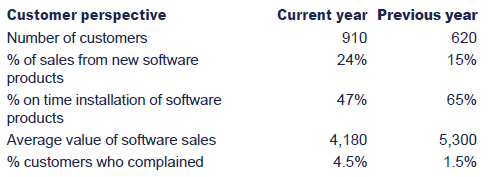


Required:
(a) Using the information in Appendix 1 only,comment on the financial performance of the company (briefly considergrowth, profitability, gearing and credit management)
(8 marks)
(b) Explain why non financial information suchas that shown in appendix 2 is likely to give a more reliable indicationof the likely future prosperity of the company than the financialinformation given in Appendix 1.
(5 marks)
(c) Using the data from Appendix 2 comment onthe performance of the business. Include separate comments on the threeperspectives, customer, internal and learning and growth, and provide aconcluding comment on the overall performance of the business.
(12 marks)
(Total: 25 marks)

12 Divisional performance measurement and transfer pricing

 KDS
KDS
Questions
KDS is an engineering company which is organised for managementpurposes in the form of several autonomous divisions. The performance ofeach division is currently measured by calculation of its return oninvestment (ROI). KDS's existing accounting policy is to calculate ROIby dividing the net assets of each division at the end of the year intothe operating profit generated by the division during the year. Cash isexcluded from net assets since all divisions share a bank accountcontrolled by KDS's head office. Depreciation is on a straight-linebasis.
The divisional management teams are paid a performance-relatedbonus conditional upon achievement of a 15% ROI target. On 20 December20X5 the divisional managers were provided with performance forecastsfor 20X5 which included the following:

Subsequently, the manager of Division K invited members of hermanagement team to offer advice. The responses she received included thefollowing:
- From the divisional administrator:
‘We can achieve our 20X5 target by deferring payment of a $90,000 trade debt payable on 20 December until 1 January. I should add that we will thereby immediately incur a $2,000 late payment penalty.'
- From the works manager:
‘We should replace a number of our oldest machine tools (which have nil book value) at a cost of $320,000. The new equipment will have a life of eight years and generate cost savings of $76,000 per year. The new equipment can be on site and operational by 31 December 20X5.'
- From the financial controller:
‘The existing method of performance appraisal is unfair. We should ask head office to adopt residual income (RI) as the key performance indicator, using the company's average 12% cost of money for a finance charge.'
Required:
(a) Compare and appraise the proposals of thedivisional administrator and the works manager, having regard to theachievement of the ROI performance target in 20X5 and to any longer termfactors you think relevant.
(12 marks)
(b) Explain the extent to which you agree or disagree with the financial controller's proposal.
(8 marks)
(c) Explain how non-financial performance measures could be used to assess the performance of divisions K and D.
(5 marks)
(Total: 25 marks)

13 Performance measurement in not-for-profit organisations

 SATELLITE NAVIGATION SYSTEMS
SATELLITE NAVIGATION SYSTEMS
Questions
S Inc installs complex satellite navigation systems in cars, at avery large national depot. The standard cost of an installation is shownbelow. The budgeted volume is 1,000 units installed each month. Theoperations manager is responsible for three departments, namely:purchasing, fitting and quality control. S Inc purchases navigationsystems and other equipment from different suppliers, and most items areimported. The fitting of different systems takes differing lengths oftime, but the differences are not more than 25% from the average, so astandard labour time is applied.
Standard cost of installation of one navigation system

The operations department has gathered the following informationover the last few months. There are significant difficulties inretaining skilled staff. Many have left for similar but better paid jobsand as a result there is a high labour turnover. Exchange rates havemoved and commentators have argued that this will make exports cheaper,but S Inc has no exports and has not benefited. Some of the fitters havecomplained that one large batch of systems did not have the correctadapters and would not fit certain cars, but this was not apparent untilfitting was attempted. Rent, rates, insurance and computing facilitieshave risen in price noticeably.
The financial results for September to December are shown below.
Operating statement for S Inc for September to December
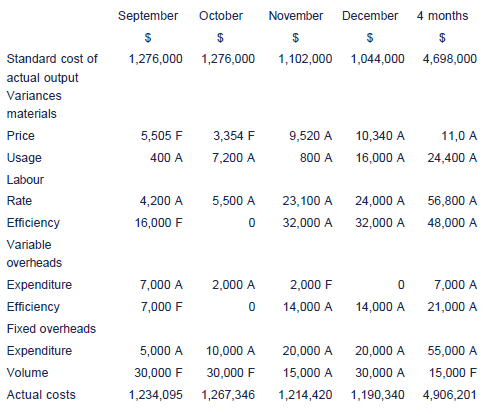
A = adverse variance F = favourable variance
Required:
(a) Prepare a report to the operations managerof S Inc commenting on the performance of the company for the fourmonths to 31 December. State probable causes for the key issues you haveincluded in your report and state the further information that would behelpful in assessing the performance of the company.
(15 marks)
(b) Prepare a percentage variance chart formaterial usage and material price for the four-month period. Explain howthis could be used to decide whether or not to investigate thevariances.
(10 marks)
(Total: 25 marks)

Test your understanding answers

 ROCHE (ABC)
ROCHE (ABC)
Answers
(a)

There are three single batches made per week, hence there are threeset-ups per week. Assuming four weeks in one month, this becomes 12set-ups per month.
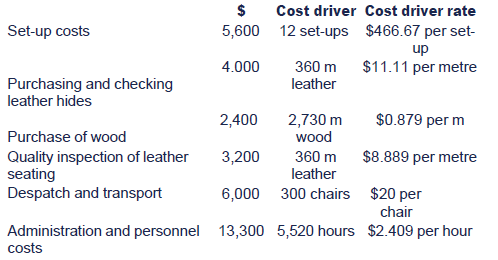

(b) ABC is a more detailed analysis ofoverheads and shows a different view, i.e. that only the simple woodenchair Type C was making a profit. The more luxurious chairs are making aloss especially the top of range Type A model. This analysis may be ofmore use for long-term planning.
The plan for the other two leather chairs needs to be reviewed.Either the overhead costs for purchasing leather and quality controlmust be reduced and/or the sales prices need to be revised upwards. Ifthese options are not viable then Roche may need to downsize thebusiness and produce a single product, the Type C.


 HENSAU LTD
HENSAU LTD
Answers
(a)
(i)The existing overhead absorption rate is:

Unit cost
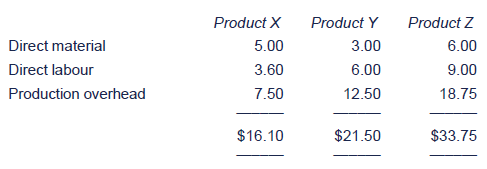
(ii) Cost driver rates


Workings
(W1) Material receipt/inspection

(W2) Process power

(W3) Material handling

(iii)ABC will have the following implications for Hensau:
- Pricing can be based on more realistic cost data - the cost per unit under ABC has increased by 26.6% for product X whereas the cost per unit has decreased by 15.7% for product Y and 13.1% for product Z. The price of the products will be based on this more realistic cost and therefore pricing will be improved.
- Decision making will be improved - the more realistic product costs means that Hensau can focus on the products which give the highest margin and may decide to stop selling products which give a low or negative margin. Information on sales prices would be required in order to calculate these margins.
- Performance management can be improved - Hensay will focus on the most profitable products and, as a result, performance should be improved. In addition, control should be improved since the more realistic costs will form the basis of the budget.
(b)A cost driver is that factor which is mostclosely related to the way in which the costs of an activity areincurred. It could be said to cause the costs. Under ABC we do notrestrict ourselves to just six possible OARs. We choose whatever basiswe consider suitable to charge overheads to the product.
A good example of the superiority of ABC over absorption costingis that of process power in part (a) above. Under traditional absorptioncosting Product Z was the dearest for process power merely because itused the most labour hours per unit. - a fact completely and utterlyunconnected with the way in which process power costs are incurred.Under ABC we investigate the business and actually take the time to findout what factor is most closely related to the cost and use that factorto charge overheads. Here we find that Product X should be the dearestbecause it uses the most power drill operations.
ABC supporters would argue that this cost/power drill operationis useful information. Costs are $1.0773 per power drill operation andthus product X costs $6.46. This cost is not insignificant and in factis nearly as much as the direct material cost and direct labour costcombined. It would be inconceivable that the direct material costs anddirect labour costs would not be very carefully controlled and yet undertraditional absorption costing the process power costs would beincluded within the general overheads and would not be subject to suchsevere scrutiny. Under ABC, once we realise that power drill operationscost $1.0773 each then when designing new products, we would have bettercost information and thus would be able to make better informeddecisions.


 QUARKO CO
QUARKO CO
Answers
(a) Department shortfall

(b) Optimum production plan
Let x = number of units of Xerxes produced each week
y = number of units of Yoraths produced each week
C = total contribution per week
Contribution per unit is as follows.

The objective function is to maximise
C = 15x + 10y
subject to constraints of

The optimum point is where (2) and (3) cross.

Therefore the optimum production plan is to manufacture 80 of both.
This gives a budgeted profit as follows.
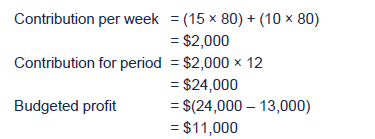
(c) Obtaining extra machining hours
Suppose one extra hour of machining time was available each week.
The optimal solution would now be found at the intersection of

Solving these simultaneously gives x = 80½ and y = 79½ and a total contribution of
C = (15 × 80½) + (10 × 79½) = $2002.50
This is an increase of $2.50 over the existing optimal solution.
Quarko would thus be willing to pay a premium of $2.50 over thenormal cost ($6 per hour) for extra machining hours or $8.50 an hour.


 CAR COMPONENTS INC
CAR COMPONENTS INC
Answers
(a) Relevant costs are as follows:
(b) The following considerations should be taken into account when putting together a tender:
- A calculation of the extra costs involved in continuing the contract is shown in part (a) and would tend to indicate that the minimum price that could be offered is $7,650,000. At this price, however, CCI will not make any contribution to its profit.
- The calculation was based on the estimates provided but any change in these could lead to losses on the contract if this minimum price was quoted.
- The original pricing policy of cost plus 25% allowed CCI a large margin, which may have encouraged the company to ignore possible production inefficiencies.
- It is likely, however, that in order to secure this price in the past CCI will have had to reveal its costs to Victor Motors. This will have given the customer considerable power over CCI and is therefore a disadvantage of such a policy.
- However, the specialist nature of Victor Components would suggest that there may be quality issues and other teething problems if Victor awarded the contract to a new supplier.
- CCI has enjoyed a long business relationship with Victor and it is important that it continues to stay on good terms with the Victor management as they are likely to have a major impact on the awarding of the contract. They may also be able to advise on the likely price level of the successful bid
- CCI also needs to find out from Victor management how likely it is that the contract will actually be awarded to different companies each year, or whether there is a strong possibility that the initial successful bid will keep the contract for some time. The incremental costs in part (a) have been based on one year only.
- If CCI were to lose the contract, it may have an impact on its reputation in the car industry and a consequent loss of business from other sources.
- It will be important to know what other component manufacturers are likely to be involved in the tender. CCI must try to identify possible rivals and then estimate the general nature of such competitors' costs and therefore possible tender levels.
- Other firms are also likely to have spare capacity, so may bid on the basis of variable rather than full cost. However, competitors may have to commit to significant investment in new machinery and retooling to be able to make Victor's specialist components.
- Victor currently accounts for 40% of CCI's output. Should the contract be lost CCI would result in operating at only 42% capacity (70 x 60%). It is questionable whether CCI would remain a viable operation under such circumstances.


 ACCESS INC
ACCESS INC
Answers
(a) Buy v Make

Note: In either case, 10 external sales of power unitswill be lost as these are now used internally. You could have includedthe cost of these lost sales in both of the above calculations. It isquicker to recognise they are a common cash flow and hence not relevantto the decision.
On the basis of the information given the required seats should be bought in rather than made.
The following factors should also be considered before a final decision is made:
- The external supplier can produce seats of the same quality as Access Inc.
- Customers will not view bought-in seats as inferior.
- Dependence on an external supplier of extra seating assemblies does not lead to difficulty in maintaining sales volume in the future.
- None of the apportioned overheads are incremental – see answer to part (b) below.
- The average variable costs of production calculated above are constant over the relevant range of output, i.e. no economies of scale or learning effects result from the increased production.
- No goodwill is lost by the reduction in sales of power units to the existing external clients.
- No additional transport costs are encountered.
- Demand will be maintained at the increased level
(b) Relevance of overhead cost figures
In the short run apportioned overhead costs are not relevant tothe decision, on the assumption that they are all fixed and notvariable. Therefore the decision is not affected by their apportionment.However, in the long run all costs become relevant and, given therelatively high fixed cost/unit charge to the seating department, thedecision may need further consideration.


 BROWN LTD
BROWN LTD
Answers
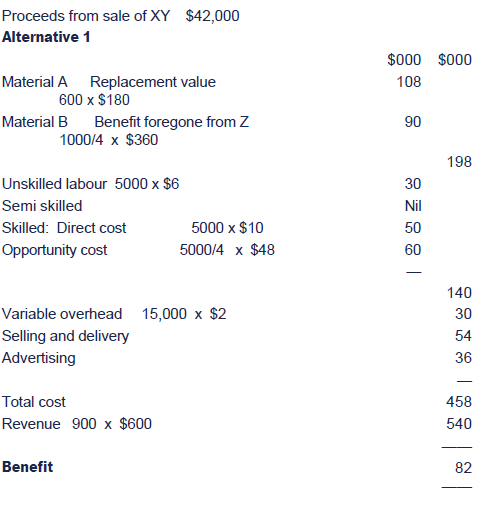
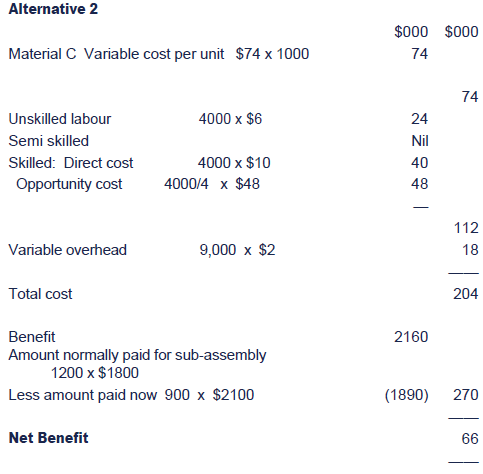
In conclusion, Alternative 1 is preferable to both selling material XY and Alternative 2.


 CARIBEE LTD
CARIBEE LTD
Answers
(a) The question asked how would the company'sforecasted profits be affected if product C were discontinued. There aremany ways of answering the question. The method shown below re-presentsthe table without Product C and using marginal costing principles, asabsorption costing ideas would never help us a make a short termdecision.

If Product C were discontinued, profit would fall by $8,000 to$13,000. The $8,000 represents the lost contribution from Product C.
I have assumed that the fixed costs will not change as a resultof the decision. If some of the fixed costs were specific to Product C,then if Product C were discontinued then those specific fixed costswould be avoidable. I have assumed that this is not the case.
(b)This is a limiting factor decision - thelimiting factor being kg of material. The decision is made on the basisof contribution per unit of limiting factor, i.e. contribution per kg ofmaterial.
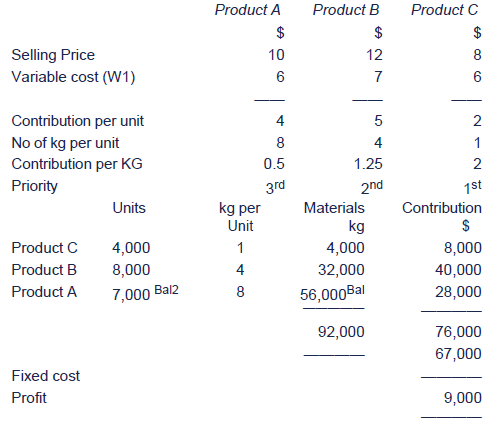
Workings
(W1)
We are told the selling price per unit and the total sales in $000. We can therefore work out budgeted no. of units sold.

We can then work out the variable cost per unit:



 PRODUCT TOM
PRODUCT TOM
Answers
(a)
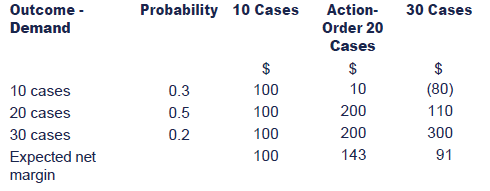
(b) If Amanda wishes to maximise E.V. she should order 20 cases per day.
| (c) |  |
If Amanda wishes to maximise E.V. she should order 20 cases per day.
(d)

Amanda should order 20 cases per day.


 SITERAZE LTD
SITERAZE LTD
Answers
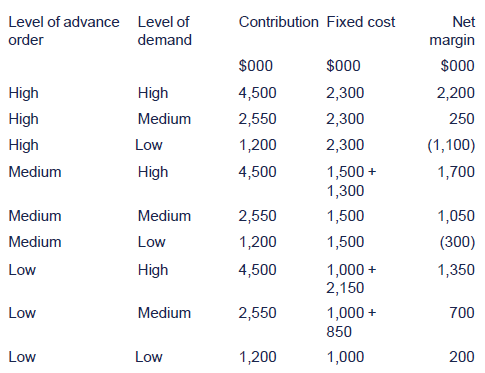
Workings
Variable cost is 70% of turnover, so contribution is 30% of turnover, therefore:


The advance order should be placed at the medium level. The expected net margin would be $807,500.
(c) This is a rather obscure reference tomaximin and maximax. The tiny clue being that maximin is a risk-aversetechnique and maximax is a risk-seeking technique. (Expected values is arisk-neutral technique.)
Maximin
For each option calculate the worst possible outcome and then choose the best of those. This is a pessimist's viewpoint.

Using this criterion the advance order should be placed at the lowlevel. Net margin would be at least $200,000. This attitude would bedescribed as risk-averse.
Maximax
For each option calculate the best possible outcome and then choose the best of those. This is an optimist's point of view

Using this criterion the advance order should be placed at the highlevel. Net margin could be as much as $2,200,000. This attitude wouldbe described as risk-seeking.
Expected values
Using an expected value criterion would be described as risk-neutral. We have seen in part (b) that using this criterion would result in the advance order being placed at the medium level.


 BUDGET BEHAVIOUR
BUDGET BEHAVIOUR
Answers
(a) An answer should cover four purposes from the six provided below.
Planning
The budget is a major short-term planning device placing theoverall direction of the company into a quarterly, monthly and, perhaps,weekly focus. It ensures that managers have thought ahead about howthey will utilise resources to achieve company policy in their area.
Control
Once a budget is formulated a regular reporting system can beestablished so that the extent to which plans are, or are not, being metcan be established. Some form of management by exception can beestablished so that deviations from plans are identified and reactionsto the deviation developed if desirable.
Co-ordination
As organisations grow the various departments benefit from theco-ordination effect of the budget. In this role budgets ensure that noone department is out of line with the action of others. They may alsohold in check anyone who is inclined to pursue his or her own desiresrather than corporate objectives.
Communication
The construction of the budget can be a powerful aid to definingor clarifying the lines of horizontal or vertical communication withinthe enterprise. Managers should have a clearer idea of what theirresponsibilities are, what is expected of them, and are likely to workbetter with others to achieve it.
Performance evaluation
When budgets are ‘tailored' to a department or manager theybecome useful tools for evaluating how the manager or department isperforming. If sales targets are met or satisfactory service providedwithin reasonable spending limits then bonus or promotion prospects areenhanced.
Motivation
The value of a budget is enhanced still further if it not onlystates expectations but motivates managers to strive towards thoseexpectations. This is more likely achieved if a manager has had someinvolvement in the budget construction, understands its implications andagrees it is fair and controllable by him/her.
(b) If budgetary control is to be successful,attention must be paid to behavioural aspects, i.e. the effect of thesystem on people in the organisation and vice versa. The following aresome of the points which should be borne in mind:
Budget difficulty
It is generally agreed that the existence of some form of targetor expected outcome is a greater motivation than no target at all. Theestablishment of a target, however, raises the question of the degree ofdifficulty or challenge of the target. If the performance standard isset too high or too low then sub-optimal performance could be theresult. The degree of budget difficulty is not easy to establish. It isinfluenced by the nature of the task, the organisational culture andpersonality factors. Some people respond positively to a difficulttarget others, if challenged, tend to withdraw their commitment.
Budgets and performance evaluation
The emphasis on achievement of budget targets can be increased,but also the potential for dysfunctional behaviour, if the budget issubsequently used to evaluate performance. This evaluation is frequentlyassociated with specific rewards such as remuneration increases orimproved promotion prospects. In such cases it is likely thatindividuals will concentrate on those items which are measured andrewarded neglecting aspects on which no measurement exists. This mayresult in some aspects of the job receiving inadequate attention becausethey are not covered by goals or targets due to the complexity of thesituation or the difficulty of measurement.
Managerial style
The use of budgets in evaluation and control is also influencedby the way they are used by the superior. Different management styles ofbudget use have been observed, for example:

The style is suggested to influence, in some cases, thesuperior/subordinate relationship, the degree of stress and tensioninvolved and the likelihood of budget attainment. The style adopted andits implications are affected by the environment in which management istaking place. For example, the degree of interdependency between areasof responsibility, the uncertainty of the environment and the extent towhich individuals feel they influence results are all factors toconsider in relation to the management style adopted and its outcomes.
Participation
It is often suggested that participation in the budget processand discussion over how results are to be measured has benefits in termsof budget attitude and performance. Views on this point are variedhowever, and the personality of the individuals participating, thenature of the task (narrowly defined or flexible) and the organisationstructure influence the success of participation. But a budget whencarefully and appropriately established can extract a better performancefrom the budgetee than one in which these considerations are ignored.
Bias
Budgetees who are involved in the process from which the budgetstandards are set are more likely to accept them as legitimate. However,they may also be tempted to seize the opportunity to manipulate thedesired performance standard in their favour. That is, they may make theperformance easier to achieve and hence be able to satisfy personalgoals rather than organisational goals. This is referred to asincorporating ‘slack' into the budget. In this context there may be arelationship between the degree of emphasis placed on the budget and thetendency of the budgetee to bias the budget content or circumvent itscontrol.
Any organisational planning and control system has multipleobjectives but primary amongst these is encouraging staff to takeorganisationally desirable actions. It is never possible to predict withcertainty the outcomes of all behavioural interaction however it isbetter to be aware of the various possible behavioural implications thanto be ignorant of them.


 ZERO-BASED BUDGETING
ZERO-BASED BUDGETING
Answers
Note: this answer is longer than required in the exam but gives an indication of the potential scope of an answer.
Introduction
(a) Zero Based Budgeting (ZBB) is a method of budgeting thatre-examines, at each budgeting exercise, whether the budgeted activityis to be funded at any level. Hence, the budgeting exercise begins at a zero or nil cost base.It is a device that is particularly useful when an organisation isunsure if its costs are at the most efficient levels. Most efficientcosts are not the same as minimum levels, since very low costs mightimpinge on service or product quality. The purpose of ZBB is to overcomeinefficient forms of budgeting that might lead to slack practices, which consume more resources than the most effective and efficient organisations face.
(b) There are a series of steps that would ordinarily be taken in order to implement an effective ZBB system.
The questioning of why expenditure needs to be incurred
The development of a questioning attitude to activities thatincur costs is the first step to ensuring that costs are kept to mostefficient levels. It is important to recall that ZBB, in the short term,can only change costs over which the organisation has short-termcontrol. Longer-term, or period costs, can only be changed over a longerhorizon. Taxes and other regulatory costs cannot be the focus of ZBBbecause they are difficult to influence.
Thus ZBB can be immediately effective where costs can be relatedto identifiable activities. The questions that might emerge in suchsituations are as follows:
Can costs associated with an activity be isolated? If costscannot be identified to a particular activity to a degree that providesmanagement with confidence that they can change the costs then there islittle point in applying ZBB techniques to the cost.
An even more basic question is to ask how important the activityis to the business and what, if the costs can be identified, is thetotal cost saving that might result should the activity be stopped. Inthis respect, it is important to identify effects on costs elsewhere inthe business. If the activity to be stopped absorbed fixed costs, thenthe fixed costs will have to be re-apportioned without absorption to theactivity that is to be stopped.
Moreover, there may be joint costs such that stopping oneactivity may have an uncertain effect on joint costs incurred withanother activity. Is the activity in question the cheapest way ofproviding the service or contribution to production? Thus, it isimportant not to ask simply if the costs relating to the activity arethe most efficient, but are there alternatives that might reduce costsstill further and still maintain a given level of service or production.
A more fundamental question about conducting ZBB processes iswhether the benefits of employing ZBB outweigh the costs. It isimportant to appreciate that conducting a ZBB exercise is not a costlessprocess if, as will inevitably be the case, management time isconsumed.
How a decision is made as to which activities should be provided with a budget?
Budgeted activities should be capable of being monitored andcontrolled. If an activity is recognised as a budget centre, and isgoing to be subject to a ZBB process, then it is important thatmanagement undertake the task of monitoring costs in relation toactivity and taking corrective action when appropriate. Thus, if anactivity consumes resources and is capable of being monitored andcontrolled then it should be provided with a budget. This will then makethe activity subject to ZBB processes.
‘Decision packages' are sometimes referred to in thecontext of ZBB and activities. These relate to how activities can bedescribed when thinking about how ZBB can be used to judge an activity.
There are two types of decision activity:
(1) Mutually exclusive decisions: When ZBB assessmentsare made of an activity, alternative courses of action are sometimesbenchmarked against existing activities. A choice is then made overwhich activity might be the preferable course of action. The preferredchoice will involve budgeted information, but may also involve otherfactors such as product quality and service level provision.
(2) Incremental decisions: ZBB assessments are oftenrelated to the level of activity within a budget centre. Thus, therewill be a minimum level of activity that provides the essential level ofproduct or service. This is often referred to as the ‘base' activity.Further levels of activity are then incremental and, subject tocorrectly identifying and isolating the variable costs related to anactivity, ZBB assessments can be made separately of both the base andthe incremental activities. This division might then provide managementwith an understanding of the degree of flexibility the organisation has.
What questions should be asked when budgeted activities need to be ranked to allocate scarce resources?
The allocation of scarce resources is a key management task.Scarce resources will have to be allocated to the activities of abusiness in terms of providing appropriate labour and materials, alongwith any other costs related to an activity. Whilst ZBB is most oftenapplied to support activities the technique can also be applied to aproduction process.
Some sorting of ranking will have to be applied in orderto determine which activities are funded by a budget against those thatare not. The key question for budgeting purposes relates to:
(1) defining the appropriate decision package (as described above)
(2) the importance of the activity in relation to the organisation in terms of:
- support for the organisation's objective (for example, maximising shareholder wealth)
- support for other service or product activities
(3) how the ranking system is to be used:
- are all activities to be funded above a certain rank, or
- is there a scaling of funds allocated against funds requested as determined by the rank, or
- is there a combination of methods?
Essentially, a judgement has to be made by management of thebenefit of the activity to the organisation. Theoretically, this is bestachieved by determining deprival value. In practice, deprival valuesare difficult tools and some level of arbitrary judgement has to takeplace in which non-financial factors might play a significant role.
(c) Critical assessment of the use of Zero Based Budgeting as a tool that might be used to motivate employees
The motivation of employees is one of the most difficult tasksfacing management since the problems are complex and not alwaysreferable to financial performance indicators. To the extent thatemployees are not responsive to financial performance indicators thenZBB is going to be less effective as a device to motivate employees.
The problem of employee motivation is one of achieving goalcongruence with the organisational objectives. ZBB can be useful in thisrespect as a method of tackling the problem of incentivising employeesto achieve targeted performance when a clear understanding of theactivities and their related decision packages is essential for themanagement tasks of monitoring and controlling an activity.
In this respect ZBB has the following advantages
| (d) | (1) It ensures that only forward looking objectives are addressed. This limits the potential for historical abuses in budget-setting to be established. Employees can be set targets that are consistent with the future objectives of the organisation. (2) Building 'budget slack' is minimised because, in principle, the entire costs of an activity are reviewed at each budget-setting stage. Employees are then set realistic targets that relate to activity levels that are the most efficient. (3) Managers are made to understand, as part of the ZBB process, the activity itself. This reduces tension between those who decide (management) and those who have to implement manager decisions. Claims that management do not really understand the nature of an activity are thus reduced. (4) ZBB encourages flexibility in employees since they know that, potentially, activities may be stopped. Flexibility induces goal consistency by enabling incentive schemes to reflect activity. In other words, employees are more likely to be responsive to management directives if they are aware and trust that the budget setting process encourages and supports payments that are responsive to flexibility. |
(e) The advantages of encouraging employee participation in budget-setting
Generally, participative budget-setting will result in:
(1) An informed budget-setting process, suchthat management are aware of the detail of budgeted activities asprovided by the people who work daily within the budgeted activity.
(2) Avoiding the criticism that budgets are unrealistic.
(3) Reducing the adverse effects of budget imposition when difficult management decisions have to be made (e.g. staff reduction).
(4) Employees become aware and more involvedin the management activities of the organisations. To the extent thatthey become more aware, then a greater understanding of the needs of theorganisation as a whole is reached.
(5) Co-ordination within an activity might beimproved. If activities are jointly budgeted, or are part of the sameprocess, then co-ordination between activities might be improved.
(6) Budgetary slack may be reduced as management become more aware of the operational activities within an activity.
(7) Achievable budgets are more likely to be set.
(8) When budgets are not met management are more likely to have a deeper knowledge of the operational issues involved.
(9) There is less risk that budgets will be undermined by subordinates.


 FASHION CO
FASHION CO
Answers
(a)
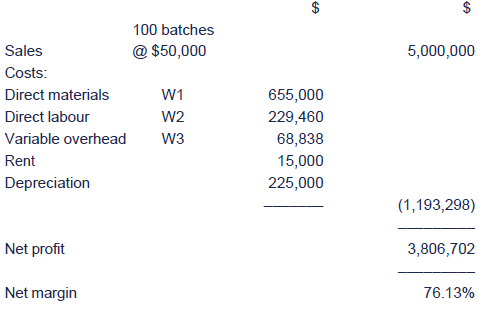
The targeted net profit margin of 80% of sales will not be achieved.
Workings
(1) Direct materials
(2) Direct labour
All batches after the first 60 will take the same time as the60th batch. To calculate the time for the 60th batch we need to take thetime of 59 batches from the time of 60 batches.
In the learning curve formula b = logr / log 2 = log0.75 / log2 = –0.415
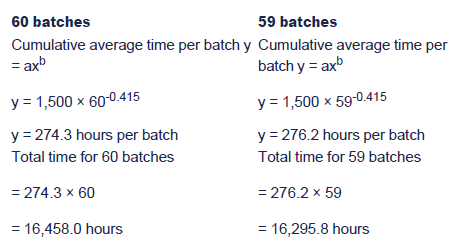
Time to make the 60th batch = 16,458.0 – 16,295.8 = 162.2hours
Total time for the 100 batches = 16,458 + (162.2 × 40) = 22,946 hours.
Total cost of the first 100 batches = 22,946 × $10 per hour = $229,460
(3) Variable overhead is 30% of direct labour = 30% × 229,460 = $68,838
(b) The learning rate measures the relationship between the average time taken between two points when production doubles. Since we:
- can work out the average rate for the two batches by X the time of the first batch by the learning factor
- can then work out the total time taken for the two batches by doubling the average rate
- know the time of first batch (1500 hours) we can then calculate the time of the second batch by simply deducting the time of the first batch from the average rate.

Note: The 70% learning rate produces a lower average time(1050 hours) than the 80% learning rate (1200 hours) and hence is thefaster learning rate of the two.
(c) Steps that could be taken to improve the net profit margin include:
- Negotiate a higher price with the retailer. The ability of Fashion Co to negotiate a higher price will depend upon a number of factors including its reputation for quality and delivery and the ease with which the retailer could find alternative suppliers that can deliver garments of the required quality and quantity by the required delivery date.
- Reduce the labour cost by identifying a simpler and faster production method that does not affect the quality or appearance of the finished garment.
- Increase the learning rate. This may be possible via a review of the training procedures and the recruitment of more highly skilled staff. Both these approaches however are likely to involve additional time and costs in the short term.
- Explore the possibility of outsourcing the production to another manufacturer in a lower cost area. This is a major step that would require careful evaluation but it has the substantial attraction - in addition to the possibility of reducing production costs – of eliminating depreciation costs of $225,000 since Fashion Co would no longer have to purchase machinery to satisfy this order.
- Explore the use of substitute materials that would not prejudice the quality or appearance of the garment. Any changes would have to be discussed and agreed with the retailer.
- Investigate ways to reduce the level of variable overhead
- Seek to deliver production direct to the retailer and thereby avoid the storage costs of $15,000.


 MALCOLM REYNOLDS
MALCOLM REYNOLDS
Answers
(a) Standard product cost
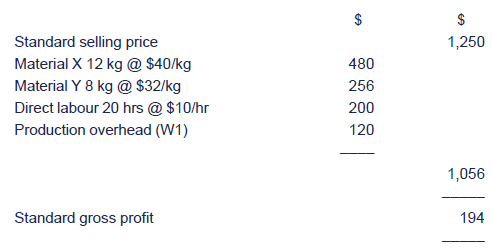
(b) Material X variances

Direct labour variances
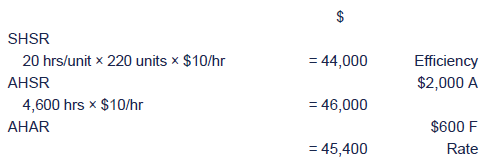
Fixed Overhead Expenditure variance

Fixed Overhead Volume variance

Sales price variance

Selling volume profit variance
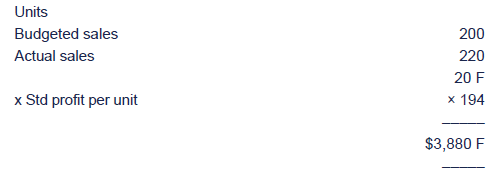
(c) Operating Statement

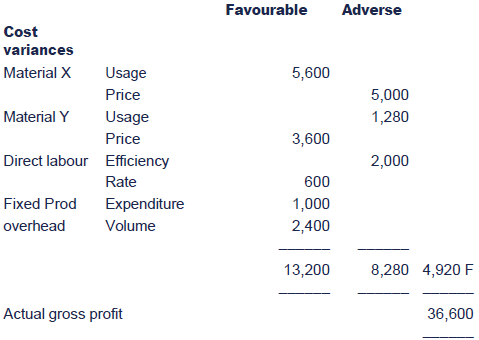
Workings
(W1) Fixed overhead per unit = $288,000/2,400 units = $120 per unit

(W3) Budgeted fixed overhead per month = $288,000/12 = $24,000
(W4) Budgeted profit = 200 units × $194 = $38,800


 MAY LTD
MAY LTD
Answers
(a) Direct labour variances

(i)$59,600 A ($12,800 A + $46,800 A)
(ii) $46,800 A
(iii)$12,800 A
Direct material variances

The requirement in part (v) asks for the price variance to becalculated at the time of issue, which is the same as at the time ofusage, so the quantity must be the quantity issued/ used.
The actual price of the material is $504,000/180,000 kg
(iv)$24,800 F ($6,000 A + $30,000 F)
(v) $30,800 F
(vi)$6,000 A
(b)
(i)Inconsistent. In fact the wage increase was $0.60 per hour higher than expected.
(ii) Inconsistent. The workforce were inefficient.
(iii)Consistent. A bulk purchase discount should lead to cheaper materials and hence a favourable material price variance.
(iv)Inconsistent. If the losses had been less than expected then the usage variance would have been favourable.


 SAM MENDES LTD
SAM MENDES LTD
Answers

Material X variances

Material Y variances


Variable overhead variances

Labour variances
Fixed production overhead variances


Selling volume profit variance

Selling price variance
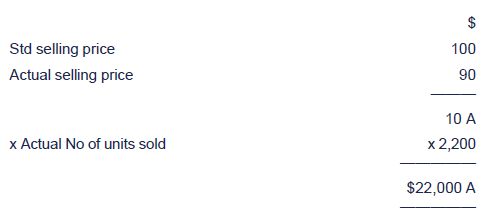
Operating Statement
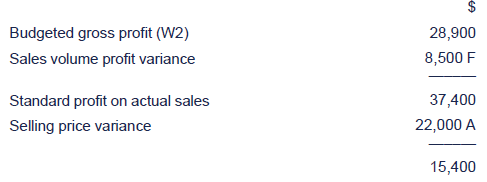
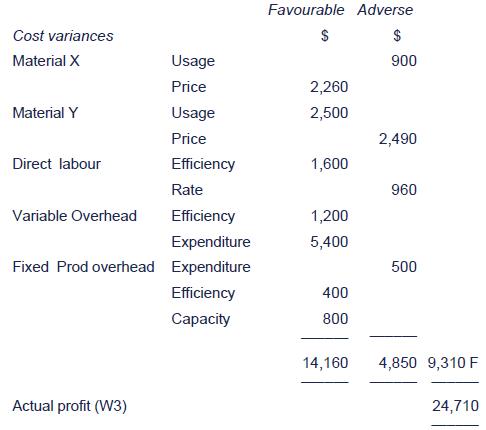
Workings
(W1)
Budgeted fixed overheads are $144,000 per year and the budgetedoutput is 24,000 units for the year. Thus the budgeted/standard fixedcost per unit is $6.
The overheads are absorbed on direct labour hours and each unittakes 3 hours. Therefore the budgeted/standard fixed overhead is $2 perhour ($6 ÷ 3 hours).
(W2)
Budgeted profit = $17 per unit x Budgeted SALES of 1,700 units = $28,900.
(W3)
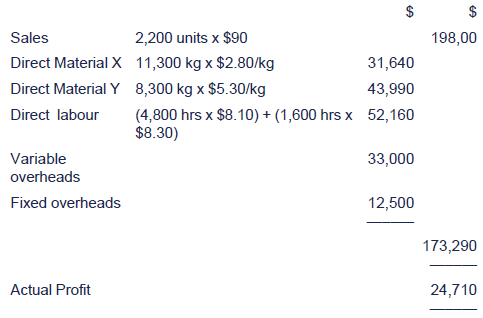


 PAINT MIXERS INC
PAINT MIXERS INC
Answers
(a)
(i)Significance and controllability of the variances
Material price variance
This variance indicates whether Paint Mixers Inc has paid more(adverse) or less (favourable) for its materials input than the standardprice set for the period. An adverse variance, for example, could bethe result of an unexpected increase in raw material prices that hasbeen passed on by their bonding agent suppliers.
Price variances are controllable to the extent that thepurchasing manager can periodically review potential sources of supplyto ensure that they are sourcing their materials from a competitivelypriced supplier. With the blue and yellow paints there is likely to be alarge number of potential suppliers so purchasing managers should beable to threaten to switch suppliers to get good deals. The company ishowever in a weaker position in relation to the pricing of bonding agentand may be unable to prevent price rises.
Material mix variance
This variance arises when the ingredients are not mixed instandard proportions and it indicates whether the actual mix is cheaperor costlier than the standard mix. For example, adding more bondingagent (relatively very expensive) and less blue paint (relatively cheap)will increase the cost of the mix. A more expensive mix will produce anadverse variance. The recipe determines the mix and the recipe isdetermined by the production manager and hence is entirely under thecontrol of the production manager.
Material yield variance
A yield variance arises when the output is less or more thanthe input should have produced and is a measure of the productivity ofthe manufacturing process. 10 litres of input produces 9 litres of greenpaint. If more than 9 litres of green paint is produced from the 10litres input the variance is favourable. A favourable yield variance canbe the result of operational efficiency (eg reduced wastage) or achange in the mix.
The production manager controls the production process and istherefore able to manage the yield. In particular, the productionmanager should be able to ensure that the appropriate quality ofmaterials are used and that wastage is minimized.
(ii)Performance of the purchasing manager and the production manager
Cost efficiency
The purchasing manager was responsible for a series ofsignificant adverse material price variances in the first three monthsof the year which averaged approx 10% of the standard monthly spend.
The adverse variances have steadily declined over the threemonths (from $3000 to $1000) and if this level of progress is maintaineda favourable variance will arise in April. We do not know whether theadverse variances were the result of poor purchasing decisions or theinevitable result of, say, increased commodity prices. The steadilyimproving trend suggests that the purchasing manager is in control ofthe situation and that he may have inherited a purchasing environment ofrising prices that were not fully reflected in the cost standards. Thecomments of the Sales Director suggest that the purchasing manager hasnot sacrificed quality in order to achieve this improving position.
The production manager was also responsible, in his first twomonths, for significant adverse variances - in relation to both the mixof materials used and the yield achieved. His performance in the firstmonth was exceptionally poor – the adverse mix and yield variances of$6,000 equalled approximately 30% of the standard monthly spend.
The production manager controls both the mix and the productionprocess and must bear responsibility for this initial very poorperformance. That said, in month three, the production manager hasachieved modest favourable mix and yield variances ($100 and $50),maintaining the improving trend that started in month two. His very poorinitial performance may, in part, have been the result of an inadequateinduction process or could have reflected a conscious attempt toimprove the quality of the output by increasing the quality of the mix.It may also be possible that certain customers requested a differentshade of green requiring a change in the mix of blue and yellow paint.
Whatever the background, the very poor yield performance inJanuary suggests that his changes to the mix had very unfortunateconsequences in terms of productivity.
Quality
The managing director will have been concerned in January andFebruary that the increasing sales and customer satisfaction levelsreported by the sales director may have been bought at a high price.
The comment of the sales director however that sales continueto rise suggests that the new production manager – after some initialcostly experimentation - has managed to identify a new mix that is bothcost efficient and very appealing to customers.
Overall
There was cause for concern in January and February over the performance of both new appointments.
The performance of the purchasing manager still continues to beof concern but is on an improving trend, which, if maintained, shouldensure that costs are brought fully under control.
The production manager, after a very worrying start, appearsnow to be delivering green paint using a recipe that is both economicaland popular with customers.
(b) Variance calculations

Note: Compare the standard prices with the actual prices and multiply the difference by the actual amounts bought
Material mix variance

Note
(1) Calculate the proportions that make up the standard mix.
(2 : 7: 1) = 0.2 / 0.7 / 0.1.
(2)Apply these proportions to the purchases made in April of 5500 litres to give the standard cost of a standard mix.
(3)Compare the results with the actual mix and × the difference by the standard price to give the mix variance.
Material yield variance
5000 – 4950 = 50 litres × $4 per litre = $200 (F)
Note
(1) Calculate standard cost of 1 litre of green paint mix ($36 ÷ 9 litres = $4 per litre)
(2) Calculate conversion factor (converts standard input of 10 litres to standard output of 9 litres) i.e. 9 ÷ 10 = 0.9.
(3) Calculate the standard output that should have been achieved from the material input (5500 litres × 0.9 = 4950 litres)
(4) Compare the actual production of 5000 litres with thestandard production of 4950 litres they should have achieved and × thedifference by the standard price of $4.0 per litre. (5000 – 4950 = 50litres × $4 per litre = $200 (F)
Actual production was 5000 litres of green paint
The actual production of 5000 litres should have cost 5000 × $4.0 = $20,000
The overall usage variance was therefore $20,000 – $19,950 = $50 (F)
There are three reasons for the favourable $50 variance:



 INSPECTION DEPARTMENT
INSPECTION DEPARTMENT
Answers
(a) Idle time variance
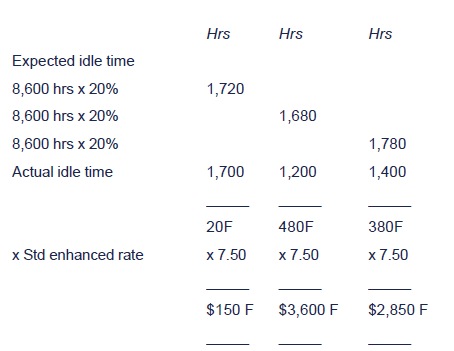

Rate variance
December
January

February

Labour rate variance
This calculates the difference between the standard cost per hour($6) and the actual cost per hour. The variance is adverse for each ofthe three months indicating that labour cost more than was expected.
Labour productive efficiency variance
This calculates if production took more or less hours thanexpected and is based on the hours worked. The efficiency variances areadverse for each month indicating that production took longer than wasexpected.
Excess idle time variance
This is the difference between the expected idle time of 20% andthe actual idle time. The variance is favourable for each monthindicating that the actual idle time is less than 20%.
(b) Idle Time


 SUCCESS SERVICES CO
SUCCESS SERVICES CO
Answers
(a) Financial analysis
This data prompts a number of comments.
Turnover. This is up substantially, an increase over theprevious year of 44%. The new MD has clearly had a significant impact.How has this been achieved?
Profit. This is also up, by 16%. However, net profits havegrown at a much slower rate than sales and this is reflected in thesharply reduced net profit margin of 20.1%, compared with 25% in theprevious year. It appears that the increased turnover may have been“bought†via price reductions and lower margins or a combination oflower prices and increased costs – perhaps increased expenditure onmarketing and advertising.
Gearing. Interest cover was 5X but has fallen to just 3X.If the company has borrowed at a variable rate it is now substantiallymore vulnerable to interest rate rises.
Average receivables days are up by 12 days – indicatingreduced efficiency in chasing up outstanding debts and / or the grantingof more generous payment terms to encourage prospective customers.
Overall, significant growth is being achieved – but at theexpense of margins, interest cover and extended credit. This is apotentially worrying trend.
(b) Non-financial information
Financial indicators tell us where the company has been – notnecessarily where it is going. They are inevitably backward looking.Furthermore, financial indicators are poor at identifying whyperformance has improved or declined – they show effects but notcauses.
Non financial measures, such as those in the Balanced Scorecard,can provide a better guide to future performance since they measureattributes which are essential to the long term success of a business– e.g. customer satisfaction, new product development, productquality, employee satisfaction and training etc.
Customer perspective is aimed at seeing the business through theeyes of its customers. It uses measures that are judged critical toincreasing customer satisfaction.
The Internal perspective considers those key internal processeswhich the business must master if it is to satisfy customers' needs andflourish. It asks what are the core competencies and criticaltechnologies that are essential to securing market leadership.
Innovation and learning focuses on whether the business cancontinue to develop and deliver value to its customers. It typicallyincludes measures such as speed to market and employee retention rates.
(c) Performance of the business
Customer perspective
Customer numbers
The number of customers has increased by nearly 50%. This is adramatic increase and suggests that there has been a major promotionaldrive to recruit new customers. The cost of such promotion may accountfor part of the reduction in the net profit margin. This recruitmentdrive may have included some form of new customer incentives such asreduced prices for a limited period and may also have included arelaxation of payment terms
% of sales from new software products
This metric also reflects a substantial increase, of over 50%,and implies that substantially increased resource has been devoted tonew product development. This focus on new development may well haveincreased costs but has the potential to lay the foundations for asustainable increase in sales.
% on-time installation of new products
This metric shows a sharp and worrying fall in the proportion ofproducts that are delivered on time, implying that the increased effortand cost expended on promotion and developing new software products maybe being compromised by a failure to meet promised delivery dates.
Average value of software sales
The average value of software sales has fallen by over 20%. Themix of sales may have changed or, perhaps more likely in view of thereduced margin data, there may have been price reductions to increasesales volume.
% customers who complained
This metric, showing a tripling in the rate of complaints,suggests that there has been a major failure to meet customerrequirements. This data should prompt an urgent review of both productdevelopment procedures and customer relationships with a view to:
A identifying what went wrong and the steps needed to prevent a recurrence of the development / installation problems and
B establishing the general level of customer satisfaction and seeking to repair any damaged relationships
Internal perspective
The launch of two new products – from a zero base in theprevious year – suggests that significant effort has gone into newproduct launches in the current year.
The two products could have been under development for some timeor they could have been initiated and launched within the current year.The launch of these new products – if they were not thoroughly testedto ensure they were bug free – could have been a major contributor tothe dramatic increase in the level of customer complaints. If it isfound that the new products were a significant contributor to customercomplaints the procedures for testing and launch of new products willneed to be reviewed.
The tender success rate has increased by just over 50%. Thiscould reflect a number of factors such as better understanding ofcustomer requirements which has been successfully translated intoproduct specifications or – much less encouraging - a decision totender at lower prices or to offer more challenging delivery dates. Thelatter interpretation appears more likely in the light of thedeterioration in service levels suggested by other indicators.
Learning and growth perspective
Programmer output has increased sharply – by some 14%. This hasbeen accompanied however by a worrying 33% increase in the number ofbugs per 1000 lines of code. Has the company been selling products thatwere released prematurely – hence the customer complaints?
The 40%+ fall in the number of development staff who havecompleted a development course and the 16% deterioration in the employeeretention rate is also indicative of increased pressure to “getproduct out of the doorâ€.
This perspective suggests that product quality – and customer satisfaction – is taking second place to a sales drive.
Overall, the company appears to have made a major change indirection under its new MD. Priority appears to have been given to shortterm sales and profit growth at the expense of customers, productquality, staff, margins, interest cover and liquidity.
The financial data shows growth but has some worrying features – margins, gearing and liquidity.
The balanced scorecard data reveals a dramatic deterioration inservice quality and customer and staff satisfaction which suggests thatthe sales and profit growth is likely to be short lived. Urgent actionis required by Michael Speed to ensure that much greater emphasis isgiven to product quality and customer satisfaction – this may meanlonger development times and a reduced rate of sales growth but this is aprice that is worth paying.


 KDS
KDS
Answers
(a) Divisional administrator's proposal
Effect on 20X5 ROI
It will have been assumed in arriving at the 31/12/X5 net assetsthat the debt will have been paid. Reversing this assumption has theeffect of increasing liabilities and has no effect on assets, as cash isexcluded. Thus net assets will be reduced by $90,000 (to $4,310,000).
Whether the $2,000 late payment penalty is accounted for in 20X5or 20X6 will depend to some extent on the company's accounting policy.The accruals concept would, however, lean towards it being accounted forin 20X5. Thus operating profits would be reduced by $2,000 (to$647,000).
The new ROI would thus be 647 ÷ 4,310 × 100 = 15.01%
Thus the target will have been achieved and bonuses paid. Thisis, of course, no indication of improved performance, but simply anarithmetical anomaly arising as a result of one side of the transactionbeing ignored in the calculation. In fact, the finance cost of the latepayment is extremely high.
Longer term effects
There would be no quantifiable long-term effects, althoughrelationships with the supplier may be adversely affected by the latepayment.
The works manager's proposal
Effect on 20X5 ROI
Assuming no depreciation charge in 20X5, net assets would beincreased by the cost of the new assets, $320,000 (to $4,720,000), andoperating profits would be unaffected.
The new ROI would thus be 649 ÷ 4,720 × 100 = 13.75%
This represents a reduction of ROI in the short term.
Longer term effects
In 20X6 and beyond, the full impact of the cost savings anddepreciation charge would be felt – operating profits would beincreased by a net $(76,000 – 40,000) = $36,000. Net assets value willbe increased, but the increase will be smaller each year as the assetis depreciated.
In 20X6, the equipment's own ROI would be
36 ÷ (320 – 40) × 100 = 12.86%
This will still not help the division to achieve its target of15%, although it does exceed the company's cost of capital and thus maybe desirable overall.
However, by the end of 20X7, the equipment WDV will be $(320,000– 80,000) = $240,000, giving a ROI of 15%, exactly on target. As itincreases above this level it will help the division to achieve itsoverall target.
This illustrates one of the major problems with using book valuesfor assets in performance measures – as the assets get older, theyappear to give better performance. This can have the effect of deterringmanagers from replacing assets even though this may be of benefit inthe long term through cost savings (as above), increased productivityetc.
(b) Residual income (RI) is an absolute measureof performance, and is arrived at by deducting a notional interestcharge at the company's cost of capital on the net assets. Appraisingthe two divisions' performance forecasts under this method would havethe following results:

In summary, RI has advantages and disadvantages over ROI as aperformance measure, and both suffer from common valuation problems. Oneof these can be used as part of a package of performance indicators –market share, productivity, employee satisfaction, technologicaladvancement, etc – but neither is perfect in isolation.
The performance rankings of the two divisions are now apparentlyreversed. However, the RIs of the two divisions are not directlycomparable – whilst Division K has produced nearly twice the level ofRI than that of Division D, the net asset base required to do this isover nine times as large. RI cannot be meaningfully used to compareinvestments of differing sizes, as ROI can.
One could also question the use of the company's average cost ofmoney in computing the notional interest charge. The two divisions havebeen set a target well above this - this may be because they areconsidered riskier than average. If 15% had been used in thecomputation, Division K would have negative RI, whilst Division D haspositive RI - reflecting the same information as the ROI, that K is notachieving its target return.
The RI uses the same principles for establishing profit and assetvalues as the ROI, and thus shares the same problems. As assets getolder and their WDV falls, the imputed interest falls and RI rises.
However, RI can be of greater benefit than ROI in managementdecision making. Management may only feel inclined to undertake newinvestment if doing so improves their performance measure. For example,Division D currently enjoys a ROI of 25% and its manager may onlyconsider new projects that give a return at least as good as this(although this may depend upon the particular structure of the bonusscheme - a fixed bonus provided the target of 15% is reached may notprovoke such an attitude).
However, the RI measure will improve with new investment, i.e.increase, provided the investment's returns are at least covering therate used in computing the notional interest (12% or 15%). This willensure that projects that are worthwhile from the company's point ofview will also be seen as such by the divisional manager (goalcongruence).
(c) Financial measures taken in isolation areunlikely to tell the whole story of a division's or company'sperformance. They must be put into context, taking account of thecircumstances in which they were achieved – new products beingintroduced, market changes, technological changes, competitors' moves,availability of resources, etc.
For example, one might question why the two divisions in KDS areapparently performing at such different levels. Whilst quality ofmanagement may well be a contributory factor, it is unlikely to explain adifference of over 10 percentage points in ROI.
The age profile of assets used should be considered, as discussedabove. Division K may have recently invested in new machinery, possiblyin response to technological advances. Not to do so would put them at adisadvantage over their competitors, and thus is for long-term benefit.The industry of the much smaller Division D may be more static,requiring less asset changes.
Performance relative to the market and competitors should beconsidered (market share, product leadership, etc) and the degree ofinnovation achieved. Level of complaints received may also be monitored.
Consider the performance of a manager – labour turnover, staffmorale, managers' relationships with both subordinates and superiors.The level of job satisfaction felt by employees at all levels is animportant consideration in the plan for achievement of companyobjectives.


 SATELLITE NAVIGATION SYSTEMS
SATELLITE NAVIGATION SYSTEMS
Answers
(a)
Report
To Operations Manager
From Management Accountant
Date May 2005
Subject Performance of S Inc for four months to 31 December
Production and sales
Production and sales were 1,100 units in September and October,950 units in November and 900 units in December. There has thus been amarked decline over the four-month period. This good performance in thefirst two months and poor performance in the latter two months may bedue to a seasonal variation. If this is the case, it would be good forthe budget to reflect the expected seasonal variation, rather than justbeing a flat 1,000 units per month.
Tutorial note: The output was calculated by taking thestandard cost of actual output and dividing by the standard cost persystem, i.e. $1,276,000/$1,160 = 1,100 units, $1,102,000/$1,160 = 950units and $1,044,000/$1,160 = 900 units.
Materials
The material price variance was favourable for the first twomonths, and then very adverse for November and December. This waspossibly due to the exchange rate movement if the systems are imported.The effect of the exchange rate variations should be quantified. Anyremaining adverse variances may be due to inefficient purchasing by thepurchasing manager. It should be investigated as to whether there arealternative suppliers for the systems.
The material usage variance was adverse in every month, but wasparticularly bad in October and even worse in December. In October thevariance was $7,200 A and as the material cost was $400 per unit, thismeant that an extra $7,200/$400 = 18 units were used on a production of1,100 units. In December, the variance was $16,000/$400 = 40 extra unitson production of 900 units. This variance could possibly be due to thelarge batch of systems which did not have the correct adaptors. Thevariance needs careful investigation in order to find out where theexcess units were used, which systems and which teams of fitters wereinvolved.
Labour
The labour rate variance was adverse in September and October andsubstantially adverse in November and December. Expressing thevariances as percentages, for September the standard labour cost was$320 x 1,100 units = $352,000 and thus the variance was $4,200A/$352,000 = 1.1% A. In November the variance was $5,500 A/$352,000 =1.6% A. These minor variances could be explained by more overtime thanexpected being worked, especially as production was high in the firsttwo months. Then things were much worse in the latter two months, forNovember the variance was $23,100 A/($320 per unit x 950 units) = 7.6% Aand in December the variance was $24,000 A/($320 per unit x 900 units) =8.3%. These substantial variances are almost certainly due to higherwage rates being offered in order to retain staff and lower the labourturnover. It would be very useful to have information on the number ofstaff leaving the business. Overtime is unlikely to be the cause for thevariances in November and December as production was lower than budget.
The labour efficiency variance was $16,000 favourable inSeptember ($16,000/$352,000 = 4.5% F), zero in October and $32,000adverse in November and December ($32,000 A/$320 per unit x 950 units) =10.5% A, and $32,000 A/$320 per unit x 900 units) = 11.1% A). It wouldbe expected that some of this variance was due to the large batch ofsystems which did not have the correct adaptors. This problem was notapparent until fitting was attempted, thus involving the fitters inextra work. If this were the case then we would expect the labourefficiency variance to tie up with the material usage variance, but itdoes not. We are also told that there is a fluctuation of ± 25% in thefitting times, so even the substantial variances for November andDecember fall within this range and thus might not representinefficiency, but simply the fitting of a higher proportion of morelabour intensive systems.
It would be useful to have information on the standard times fordifferent systems and the numbers of the different systems, instead oftreating all systems alike. The high labour turnover also means thatexperienced workers are leaving and that new workers are constantlyhaving to be trained. The efficiency of the new workers would be poor tostart off with.
Variable overheads
The variable overhead efficiency variance is based on labourhours and thus simply moves in line with the labour efficiency variance.
The expenditure variance was $7,000 A in September, improved to$2,000 A in October and then $2,000 F in November. It was zero inDecember. For this variance to have any meaning it must be sub-analysedinto its different components in order to determine which ones are beingoverspent and which ones underspent.
Taking the variable overheads as a whole, the variance gets worseas production levels fall, perhaps indicating that the variableoverheads are not entirely variable but may include a fixed element.
Fixed overheads
The fixed overhead volume variance simply reflects the betterthan expected production in the first two months and the worse thanexpected production in the latter two months. The fixed overhead volumevariance has no significance as it does not represent a cash flow (if wemake more or fewer units than expected then the fixed overheads do notchange), but is simply a mathematical device to reconcile budgetedprofit with actual profit in an absorption costing system.
The fixed overhead expenditure variance is $5,000 A, $10,000 A,$20,000 A and $20,000 A over the four months and thus shows a worseningpattern, but again in order to understand where things are going wrongwe need to sub-analyse the fixed overhead into their differentcomponents. We have been told that rent, rates insurance and computingcosts have risen in price noticeably; these costs may be regarded asuncontrollable. Managers' attention should be devoted to investigatingthe controllable costs and reducing any overspend.
Conclusion
Overall the actual cost was 4.4% worse than expected (($4,906,201– $4,698,000)/$4,698,000). Whilst this variance might not be regardedas significant, the individual variances in many cases are much biggerand should be investigated. There is a marked decline in performance inNovember and December. It is important that the individual variances areinvestigated and their causes understood so that future performanceimproves.
(b)
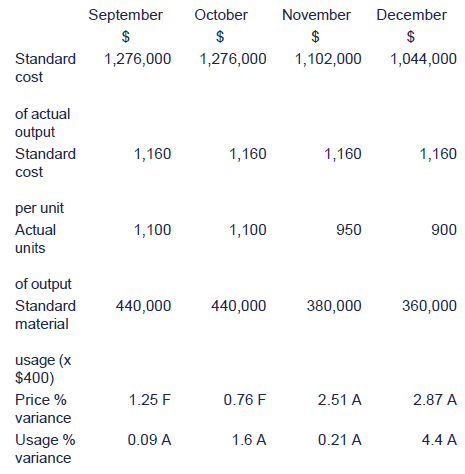
Percentage variance chart for September to December

The percentage variance chart can be used to monitor the trend ofvariances. Significant variances may be identified by setting a controllimit. If variances exceed the control limit then action is taken.Alternatively variances which show a worrying trend, such as thematerial usage variance for S limited, may be investigated before thevariance exceeds the control limit.

|
Created at 5/24/2012 4:45 PM by System Account
(GMT) Greenwich Mean Time : Dublin, Edinburgh, Lisbon, London
|
Last modified at 5/25/2012 12:54 PM by System Account
(GMT) Greenwich Mean Time : Dublin, Edinburgh, Lisbon, London
|
|
|
|
 |
Rating
:
|
 Ratings & Comments
(Click the stars to rate the page) Ratings & Comments
(Click the stars to rate the page)
|
 |
Tags:
|
|
|
|
|